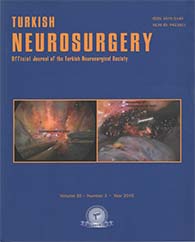2,3,4,6Baskent University, School of Medicine, Department of Neurosurgery, Ankara, Turkey DOI : 10.5137/1019-5149.JTN.2852-09.0 AIM: Coccydynia is a painful condition affecting quality of life. The majority of patients can be successfully treated by non-surgical means. Chemical neurolysis, cryoablation and radiofrequency thermocoagulation (RFT) of ganglion impar are also used in the treatment of visceral pelvic pain. We analyzed the efficacy of RFT of ganglion impar in patients with chronic coccydynia.
MATERIAL and METHODS: We retrospectively analyzed the collected data of 10 patients with chronic coccydynia (pain > 6 months) who were treated by RFT of the ganglion.
RESULTS: The mean age of the patients was 49.2±14.4 (range 27-77) with 8 females (80%) and 2 males (20%). The average follow-up duration was 9.1±1.2 months. Statistically significant differences were observed between the preprocedure and post-procedure VNSs (p < 0.01). Improvements in VNS scores were correlated with improvements in the EQ-5D scores. Midterm evaluation after the treatment (6 months) revealed that 90% of the patients had a successful outcome and 10% were deemed failures.
CONCLUSION: Our data suggest that RFT destruction of ganglion impar in patients with chronic coccydynia has an effective outcome and patients responding to RFT have significantly lower post-RFT pain scores. The most important factors determining success of this procedure is strict patient selection criteria and the technique of the procedure.
Keywords : Chronic coccydynia, Ganglion impar, Outcome, Patient selection, Radiofrequency thermocoagulation, Technique




